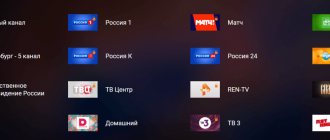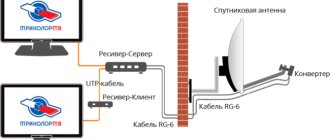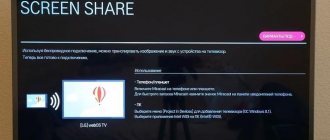DVB-T2 broadcasting and how to set it up
In Kazakhstan, there is a gradual transition to digital terrestrial television broadcasting. In information materials regarding digital TV, you can see the abbreviation “ DVB - T 2”. TV viewers often wonder what it means.
DVB-T2 stands for Digital Video Broadcasting-Second Generation Terrestria and is translated from English as “Digital Terrestrial Video Broadcasting of the Second Generation”. In Kazakhstan, the European standard DVB-T2 has been chosen as the unified DTTV standard. It allows more digital channels to be placed on the frequency band than its predecessor. DVB-T2 improves the capacity of television networks by at least 30% compared to DVB-T with the same network infrastructure and frequency resources.
The advantages of the DVB-T2 standard are an increase in the number of channels in the broadcast package, the possibility of organizing “local” broadcasting and the development of high-definition television, as well as the release of air frequencies.
The use of the DVB-T2 standard in subscriber devices makes it possible to introduce additional services and HDTV through digital terrestrial television networks. Since our country is gradually switching completely to DTTV, Kazakhstanis need to check whether their TVs support the DVB-T2 standard.
How can I find out if my TV supports the DVB - T 2 standard?
To do this, you can use the Yandex website. Market and enter your TV model in the search field. If your TV supports the digital terrestrial broadcasting standard, then in the “All characteristics” section it should be written - DVB-T/T2 MPEG4.
Most new TVs support the DVB-T2 standard. If your TV was released before 2013, then you need to buy a DVB-T2 digital set-top box, also called a receiver or TV tuner. A decimeter antenna is also required. Setting up the antenna via the receiver connection is easy. To do this you need:
— choose a suitable antenna;
— select a TV tuner with the desired set of options;
— carry out switching according to the connection diagram.
Which antenna to choose?
Antennas can be indoor or outdoor. Residents of residential complexes can unite and install one antenna per house. In private houses within the city, you can use an indoor antenna, but only with direct visibility of the television tower. For residents of houses located far from a TV tower, an outdoor antenna is suitable.
Which receiver to choose for digital TV?
The choice of receivers is large, but only one fact is important for connecting digital TV - the DVB-T2 standard. Otherwise, receivers differ in connection methods (RCA, HDMI, SCART, etc.), as well as additional options. The complete set of the set-top box includes a power supply, remote control, and instructions. The power supply can be external or built-in. The external one can be replaced in case of breakdown, the built-in one is less practical.
How to set up an antenna and a DVB - T 2?
The first step is to determine the location of the nearest tower. To do this, use online services. The nearest Tsetv broadcast point to you can be found on the website www.tsetv.kz .
Using the CETV coverage map, you can also see the transmission frequency of your channel package; the status will be indicated next to it - broadcasting, waiting.
After this, decide on the location and method of mounting the antenna. Outdoor antennas must be pointed at the signal source to improve transmission quality. Attach the antenna to the balcony or window frame. Next, we run the cable through the house to the digital set-top box.
How to connect an antenna to a digital receiver?
Turn off the TV from the network.
We connect the cable coming from the antenna, RCA or HDMI, depending on what you chose: one end to the set-top box, the other to the TV.
We turn on the TV. Select the signal source AV, HDMI. The receiver menu window should appear. On the remote control this button may be called SOURCE, TV/VIDEO, INPUT.
Select the menu items “SEARCH” - “Manual search”. Don't forget to set the UHF band. Next you will see scales of signal strength and quality.
Then we turn the antenna in different directions, choosing the ideal position, and attach the antenna.
In the menu “SEARCH” - “Auto search” the channels will be installed automatically.
Digital terrestrial television broadcasting has been operating in all regional centers since 2013. Mangistau, Zhambyl, Turkestan, Almaty, Pavlodar, Kostanay regions and the city of Shymkent have also completely switched to digital. This means that if you have an appropriate TV or an additional set-top box, you can receive and watch about 30 channels for free in excellent quality, without any interference.
If you have questions about the availability of a digital signal in your locality, you can contact the call center at numbers 193 from a landline phone and 7193 from a mobile phone - the call is free.
Enjoy your viewing!
- about the author
- Latest publications
admin
Latest publications authored by admin (see all)
- Happy professional holiday! — 11/15/2021 20:40
- Leader in housing construction - 11/15/2021 20:34
- Activity, acceleration and new niches - 11/15/2021 20:26
- Which vaccine is better for revaccination? — 11/15/2021 20:07
- TO THE 80TH ANNIVERSARY OF THE FEAT OF 28 PANFILOV GUARDS - 11/15/2021 19:49
ABS-2 satellite TV channels
- Belarus 24
- Moscow 24
- Go
- RUTV rus
- Top Shop TV Russia
- Shopping Live
- Greater Asia
- TNT4 +0
- Friday +2
- TV3 +4
- InterAz
- WORLD +0
- WORLD +4
- MIR-24
- RBC-TV
- TNT4 +2
- TNV Planet
- 360 HD
- Star +0
- Thomer
- Kaleidoscope TV
- Tochka TV
- 360 TV
- 2x2 +0
- 2x2 +2
- Moscow TV
- RT Doc HD
- Fashion TV Russia
- E
- Horse World
- LDPR Live
- World HD
- State Television and Radio Broadcasting Company Grozny
- Red line
- TV-3 (+2)
- TNT +4
- TNT +7
- TNT +0
- TV-3 (+3)
- Yu +0
- Friday (+2)
- Super
- Union
- Channel 8 +0
- Boutique TV
- Showcase TV
- Together RF
- our theme
- 2×2
- Friday Int.
- Super (+2)
- BelRos
- RT News
- 2×2 (+2)
- Open World
- 360 News
- Central TV
- Bum TV
- TV channel 360.
- Tnomer
- Fan TV channel
- Pes i Ko
- TV channel M
- TV channel Nadezhda
- Match Planet
- Phoenix + Cinema
- KinoSat
- MyzSoyuz
- MNB
- MNB World
- Hunting and fishing
- Manor
- Retro
Cable TV
As of the beginning of 2021, the technical coverage of the country's territory by cable operators was 69.7% (data from TNS Gallup Media).
The main share of the analogue CATV market belongs to. As J'son & Partners Consulting reported at the end of 2014, the operator served about 44% of pay television subscribers in the country.
At that time, AlmaTel Kazakhstan was in charge of analog television, and IPTV and digital cable television were provided by Kazakhtelecom (under the iDTV and Digital TV brands, respectively). At the same time, at the end of 2014, the operator’s IPTV network served about 20% of the republic’s pay television subscribers, and the digital television network served about 12%.
After the publication of these statistics, AlmaTel Kazakhstan launched the interactive service Alma TV Box - television through any Internet operator, and Kazakhtelecom launched the Internet project Galam TV with Kazakh TV channels available all over the world. Along with the abolition of tariff regulations, this may change the market shares of the main players.
About 16% of pay television subscribers in Kazakhstan in 2014 were served by other operators - essentially, local cable providers (with the exception of a small share of the above-mentioned commercial terrestrial TV).
Satellite television
Currently there are two satellite operators in Kazakhstan: Caspio HD and Alma TV. Both have been on the market relatively recently.
Caspio HD (owned by Modern Nomads Entertainment and BSG Technology) launched in early 2021, focusing on premium content against the backdrop of the then only Otau TV with limited satellite capacity.
Satellite television Alma TV (owned by AlmaTel Kazakhstan) was launched in the spring of 2021; By the end of the year, the operator reported its first ten thousand subscribers. It is noteworthy that the operator launched broadcasting with the HEVC codec, initially focusing on “heavy” content that would be difficult to transmit over the Internet, and immediately introduced one 4K channel in the package.
Otau TV (Kazteleradio project), which has been present on the market since 2011, ceased commercial activities on January 1, 2021, now complementing the on-air digital project - distributing a package of 41 public channels in DVB-S2 format. Delivery of the signal of these channels to the subscriber is paid by the state. The company's subscriber base is estimated to be about 1 million households, while, according to J'son & Partners Consulting, at the end of 2014 the operator served about 8% of pay television subscribers in the country. The company's communications explained the departure from the market of paid services due to the unprofitability of the service after the devaluation of the national currency.
With a high share of the rural population (about 47%) and low penetration of pay television outside large cities, the satellite television market in Kazakhstan was predicted to grow actively. However, a serious problem in the development of national satellite operators in Kazakhstan is the “gray” subscribers who receive satellite television from Russian and Chinese platforms. To combat illegal connections, a law was passed at the end of last year recognizing the existence of “gray” dishes and their distributors, as well as outlawing the activities of the latter. We wrote about it in detail in the article “Ban of “gray” plates in Kazakhstan. Step 1: acknowledge existence.” It is too early to judge how the provisions of the law will be implemented in practice.
TV channels of the Yamal-401 satellite
- Channel 7
- Russian Musicbox
- Music Box
- Shop 24
- STS Love
- Muz TV
- U (+7h)
- Chanson TV
- 8 channel
- TNT Music
- TNT 4 (+5h)
- TNT (+2h)
- Telekanal 2×2 (+5h)
- First channel (+2h)
- 5 Channel (+2h)
- Russia 24
- 1 Russia
- Yugra TV
- NTV (+2)
- Match!
- Russia K (+2h)
- Amurskoe TV
- Yamal TV Region
- Super
- Studio Fact
- OTV Primorye
- Business 24 TV
- Angel TV Russian
- TBN Russia
- The Word Network
- TNT (+4h)
- Russia 24
- NTV (+4h)
- Jeweler
- Showcase TV
- Leomax
- Khabar 24
- Bashkir satellite
- Kurai
- Kazakh TV
Television is digital, and competitions are the old fashioned way
However, even the willingness to pay for a place in multiplexes is not a guarantee that you can get into it. It is especially difficult for private regional channels. Whether the channel will be in the multiplex or not is decided by a special commission, which includes deputies, officials and representatives of NGOs.
“According to paragraph 20 of the rules, the selection criteria for determining the winners are thematic focus and genre ratio, the volume of own television and radio programs, purchased television, radio programs and rebroadcasts, the volume of broadcasting in the state language, the average daily broadcast time, human resources (hereinafter referred to as the criteria) “- says the official response of the Ministry of Education and Science of the Republic of Kazakhstan to the editor’s request.
Pay TV
At the end of 2021, according to J'son & Partners Consulting, the penetration of pay television in the republic was 31% of households. Back in 2014, it was assumed that penetration would grow at a rate much faster than in Russia, up to 49% at the end of 2017. However, the real growth rate turned out to be almost zero: for two years - from 2014 to 2021 - the penetration of pay television has not changed (data for 2021 at the time of writing this article is not yet ready).
The bulk of pay television subscribers are concentrated in cities; accordingly, IPTV operators and cable companies working with different signal delivery technologies have the largest share. At the end of 2021, according to Json & Partners, cable operators served 60.8% of the pay television subscriber base, and IPTV operators - 29.5%. At the same time, subscribers are gradually switching to digital technologies - according to data for 2021, the share of digital television was 47%. The transition to digital is actively promoted by the operators themselves, since this solves the long-standing problem of controllability of the subscriber base and illegal connections.
Satellite operators also occupy a significant share of the market. They (according to J'son & Partners Consulting) account for 9.7% of pay television subscribers. In one of the regions of the country there is also a commercial broadcast digital broadcast, but on the scale of the entire republic its share is small.
The difficulty of analyzing the Kazakhstan market lies in the fact that such statistics take into account only operators officially operating in the country. At the same time, foreign satellite operators have a significant market share, unwittingly. According to estimates by Askar Khairushev, Chairman of the Board of Kazteleradio JSC, their share reaches 34%.
In general, the situation in the pay television market of the republic is not the most rosy. The devaluation of the tenge and the general economic downturn have led to the fact that, with a general increase in the number of subscribers, they prefer to subscribe to basic offers, reducing the consumption of paid services. However, despite this, according to J'son & Partners Consulting, the ARPU of pay TV in Kazakhstan is higher than in Russia - $5.2 versus $2.5, and the share of pay TV costs in average household income is twice as high.
Is further more expensive?
Currently, the tariffs of Kazteleradio JSC are in the so-called transition period: TV channels reimburse only the company’s direct costs without taking into account depreciation. This means that when the transition period ends, tariffs will become higher.
“After the completion of the transition period with the shutdown of analogue television broadcasting on the territory of an administrative-territorial unit, the distribution of television channels through the CETV network in accordance with paragraph 4 of Article 42 of the law is carried out in accordance with established tariffs on the basis of concluded agreements,” explains Vice-Minister of MIOR RK Mauberlinova in response to a request from informburo.kz.
As Kazteleradio JSC reported, “in accordance with the financial and economic model of the project “Implementation and development of digital terrestrial television and radio broadcasting in the Republic of Kazakhstan,” the payback of activities implemented at the expense of budget funds is determined to be 15-17 years, until 2037.” In the company of Fr.










